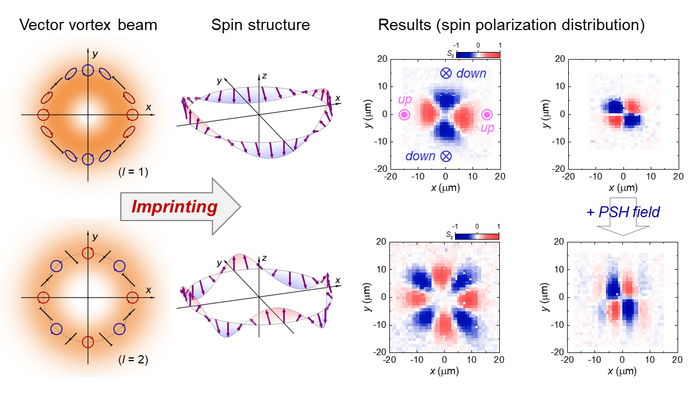Light is composed of electric and magnetic fields that oscillate perpendicular to each other. When these oscillations are restricted, say, along a plane, it results in polarized light. Polarized light is of great importance in optical communications and can similarly revolutionize how information is stored.

Credit: Jun Ishihara from TUS, Japan
Light is composed of electric and magnetic fields that oscillate perpendicular to each other. When these oscillations are restricted, say, along a plane, it results in polarized light. Polarized light is of great importance in optical communications and can similarly revolutionize how information is stored.
Current electronic devices store information in the form of electronic charge. However, spin – a uniquely quantum property of electrons – offers an alternative. The spin can be controlled using polarized light to store information. A polarized light beam interacts with electron spins within a semiconductor to generate spin-polarized electrons, i.e., spins aligned along a specific direction. So far, only uniformly polarized light, i.e., light with a spatially uniform polarization, has been exploited to control electron spins. If, however, the polarization has an additional spatial structure (variation), it can produce spatially structured electron spins, opening up new ways to store information.
To this end, a group of researchers, led by Junior Associate Professor Jun Ishihara from and including Graduate Student Takachika Mori, Graduate Student (at the time of the research) Takuya Suzuki, and Professor Kensuke Miyajima from Tokyo University of Science (TUS), Japan, has now devised a method for generating such spatially structured electron spins using a structured light with spatially varying polarization profile. The study, published in the journal Physical Review Letters, was done in collaboration with research groups from Chiba University, Tohoku University, and Tsukuba University in Japan.
“In this work, we generated a doughnut-shaped structured light–a vector optical vortex beam with an orbital angular momentum (OAM)– from a basic Gaussian beam using vortex half-wave plate and quarter-wave plate devices. We then used this beam to excite the electron spins confined within a gallium arsenide/aluminum gallium arsenide semiconductor quantum well. These spins, in turn, formed a helical spatial structure in a circle,” explains Dr. Ishihara.
Interestingly, while the beam with an OAM number equal to one produced a helix with two spin periods – spin up and spin down – around the circle, an OAM number of two resulted in a helix with four such alterations. These observations indicated that the spatial polarization structure of the optical vortex, determined by the OAM, was transferred to the electron spins inside the semiconductor. In addition, increasing the OAM number was suggested to enable higher information storage capacity, characterized by higher spin repetition rate around the circle.
Moreover, the researchers utilized the effective magnetic field of the spin-orbit interaction acting on electron spins in the quantum well to simultaneously generate two spin waves with opposite phases in the vertical direction using a single beam. This suggested that various spin states with spatial structures could be produced by exploiting the effective magnetic fields (a characteristic of solids) alongside structured light beams.
With such exciting results, the researchers discuss the future prospects of their work. “The conversion of the spatial polarization structure of light into a spatial structure of spin along with the generation of new spin spatial structures in combination with effective magnetic fields in solids are expected to lead to elemental technologies for higher-order quantum media conversion and information capacity enhancement using spin textures,” says Dr. Ishihara.
It may not be long before such spin-based information storage devices become a reality!
***
Reference
DOI: https://doi.org/10.1103/PhysRevLett.130.126701
About The Tokyo University of Science
Tokyo University of Science (TUS) is a well-known and respected university, and the largest science-specialized private research university in Japan, with four campuses in central Tokyo and its suburbs and in Hokkaido. Established in 1881, the university has continually contributed to Japan’s development in science through inculcating the love for science in researchers, technicians, and educators.
With a mission of “Creating science and technology for the harmonious development of nature, human beings, and society,” TUS has undertaken a wide range of research from basic to applied science. TUS has embraced a multidisciplinary approach to research and undertaken intensive study in some of today’s most vital fields. TUS is a meritocracy where the best in science is recognized and nurtured. It is the only private university in Japan that has produced a Nobel Prize winner and the only private university in Asia to produce Nobel Prize winners within the natural sciences field.
Website: https://www.tus.ac.jp/en/mediarelations/
About Junior Associate Professor Jun Ishihara from Tokyo University of Science
Jun Ishihara is a Junior Associate Professor at the Department of Applied Physics, Faculty of Science Division at Tokyo University of Science (TUS) in Japan. He received his Ph.D. from the Department of Electronic Engineering at Tohoku University, Japan, in 2014. Over the last decade, he has published 15 research articles with around 100 citations to his credit. His research interests include spintronics and semiconductors, applied materials, condensed matter physics, and spin dynamics.
Funding information
This work is supported by JSPS KAKENHI Grant Nos. JP18K14113, JP21K14528, JP21H04647, and JP22H01981, the Shimadzu Science Foundation, the Murata Science Foundation, JST FOREST Program, the Cooperative Research Project Program of RIEC, and Center for Spintronics Research Network, Tohoku University.
Journal
Physical Review Letters
DOI
10.1103/PhysRevLett.130.126701
Method of Research
Experimental study
Subject of Research
Not applicable
Article Title
Imprinting spatial helicity structure of vector vortex beam on spin texture in semiconductors
Article Publication Date
24-Mar-2023




